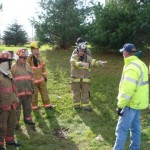 Fire Officer Roles and Responsibilities
Fire Officer Roles and Responsibilities
The modern fire officer faces many challenges in today’s fire service. With the increase in demand for services at a lower cost, increased responsibilities for following governmental mandates, recruitment and retention, the fire officer must possess certain skills and qualities, such as verbal and written communications, technological ability, planning and organizational skills. The modern fire officer not only is the leader on the fire ground, he or she must also be a leader to their subordinates, a liaison to the city council and available/approachable to the public.
One of the essential skills that a fire officer must possess is communication. The officer must be a good listener and be able to “read between the lines” during conversations to pick out the non-verbal communication clues. After listening to what a person has to say, the officer must be able to articulate their point of view on the subject and when needed, develop an action plan to address the issue. With the ever increasing use of social media and texting, an officer must avoid the pitfalls of not using proper grammar in written communications, so as not to have the message misunderstood or mis-interpreted.
Other essential skills are planning and organizing. The fire officer wears many hats to complete their job. The fire department can be broken into both line and staff functions. Line personnel are those that function at the emergency scene while staff functions are roles used to support the line functions. In volunteer or paid/on-call departments, the fire officer may be filling several roles. For example, the Assistant Chief may also be responsible for equipment and training resources in addition to operational responsibilities on the fire ground. If the officer is not good at planning and organizing, key training metrics may be neglected or equipment maintenance issues may go unfulfilled.
Technology is always changing. Today’s fire officer needs to be able to keep up with technology changes not only on the fire scene, but also the increased visibility through social media. While fighting fire has not changed much, the tools and techniques for fire-fighting have changed. An officer must be able to make quick decisions on the fire ground. Technology has given multiple ways for officers to continue to hone their fire ground leadership skills, such as computer simulations. These simulations are a safe way to try alternative techniques or “fail” in order to learn. Other advances in technology made a canister available that can be thrown into a room (room and contents) and the canister will suppress or greatly reduce the fire increasing firefighter safety and buying time for the attack crew to have a rapid intervention team in place before going into the structure. There are also electronic accountability system that can be used on the fire ground to help keep track of personnel.
Social media is an area that can help or hurt a fire department. The fire officer must be aware that each and every move that the department makes could be on video. Inappropriate language or gestures may be captured and shared on social media sites, showing the department in a not so favorable light. Now, more than ever, employees are using social media to air workplace grievances. Policies that govern what content is acceptable and what is not acceptable must be established. Social media can also be used to the fire officer’s advantage. Fire prevention activities, fund raising and general information can be accessed by the public on websites or social media, helping to raise awareness and inform the public.
Fire fighting skills and qualities of the fire officer are important and their roles and responsibilities are equally critical. The fire officer is a leader in the department. All officers need to be leaders. Leadership is critical on the fire ground as well as in the fire house. Leadership in the fire house is important, where leading by example can be a powerful tool. Helping with daily duties, rig checks, etc. can help build a true team between the officer and their firefighters. The lesser ranking fire officer needs to be a conduit for their fire fighters by bringing important issues that they cannot solve on their own to the higher ranking fire officers. Being visible and available is equally important. It is hard to know what is going on in the fire house if the officer does not leave their office.
Another critical role for a fire officer, especially a chief officer, is the liaison with the political climate. In one form of government, the Fire Chief reports to the Mayor and city council. The working relationship between Chief, Mayor and city council needs to be a productive one. The Mayor and council controls the funding for the department. The Fire Chief must justify the current use of funds as well as any new expenditures and future budgets. Regular communication both written and oral, will help foster a positive relationship.
Most of the public does not have an opportunity to get a real understanding of what it takes to be a fire fighter. The fire officer needs to be a positive spokesperson to the public. When someone in need does not know who to call to help them, they often call the fire department. The fire service has increased their public service roles from fire and rescue responses, to hazardous materials, technical rescue and emergency medical services. Keeping the public informed is an important function. If the public is not aware of fire department services or needs, then the public may be unwilling to vote yes for a tax referendum for a new truck or question why a certain piece of equipment is at the station. Fire prevention activities is a positive way to help interface with the public, including the activities that are conducted at schools within their response jurisdiction.
Recruitment activities are fundamental for departments that rely on volunteers or paid/on-call members. Usually the economic incentive is not the reason that a person wants to help their community by becoming a volunteer fire fighter. Thus, the fire officer must be able to show potential candidates what the requirements of the job are and how their involvement can make a difference.
The modern fire officer needs to be a leader on the fire ground and in the fire house, a liaison to the city and approachable to the public. Possessing skills and qualities such as excellent communication, organizational development and using technology to their advantage will aid the modern fire officer to be successful at their job.









